Games boxes are very collectible but if they contain their original games it can also make them very valuable. Games boxes often contained, and still do, an assortment of games such as playing cards or board games etc.
Below are some examples and price guides of antique games boxes including a bone box from the Southern Netherlands and a medieval traveling box.
Game Box for Playing Senet and Twenty Squares ca. 1635–1458 B.C.
The upper and lower surfaces of this box are each configured for a different board game. The side visible in this photograph has twenty squares for a game that was introduced into Egypt from the Ancient Near East. The other side has thirty squares for the Egyptian game known as Senet. These were both games in which two players raced each other for position, using knucklebones or throw sticks as dice to determine each play. For this game box, eight of the original gaming pieces and two bones are preserved. The pieces would have been stored in a drawer that could be closed with an ivory bolt.
Reference: The Metropolitan Museum of Art
Games box containing packs of cards (5), score boards (3) and instructions booklets (2), wood / paper / metal / ivory, various makers, England, 1780 – 1800
Reference: Museum of Applied Art and Sciences
Game pieces Egyptian New Kingdom, early Dynasty 181539–1458 B.C.
Game pieces, seven of conical shape with ball tops and four of spool type, for Senet. Faïence and wood
Reference: Museum of Fine Arts Boston
Southern Netherlandish, second half 15th century GAMES BOX WITH COURTLY SCENES bone, with extensive traces of gilding and polychromy, on a wood core, with metal mounts 7.5 by 15 by 18cm., 3 by 5 7/8 by 7 1/8 in.
This charming games box is a fine example of a distinct group of small bone caskets displaying secular motifs in low relief against hatched backgrounds and intarsia checkerboards to the underside. Today’s scholarly consensus argues that these caskets were produced by workshops in the southern Netherlands. Their preferred motifs – scenes of courtship and hunting – indicate a possible function within marriage negotiations. While it is traditionally thought that these caskets were in fact used to store gaming pieces and to play on, this use has been called into question, and the checkerboard should perhaps be seen as symbolic in most cases.
Sold for 5,000 GBP at Sotheby’s in 2019
This games box originated at the court of the Maharaja Krishnaraja Wadiyar III. He was ruler of Mysore from 1794 to 1868 and a skilful games player. His abiding interest in the board games of his own country led him to develop both variations of existing games and entirely new ones. The 11 games in this box vary from complicated to very simple. The inlays suggest that the box was originally issued with ornate pieces that were kept in the two storage drawers.
Reference: © Victoria and Albert Museum
Board games including chess, checkers, and backgammon became increasingly popular in Europe during the later Middle Ages. Chess had been brought back by crusading knights from the Near East. Small boards, such as this on the underside of a box in which the game counters or pieces were kept, may have been made for traveling. The box is decorated with scenes of dancing and hunting on the top and sides.
Reference: The Walters Art Museum
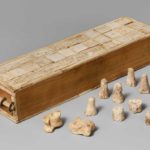
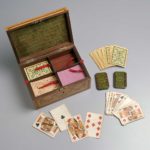
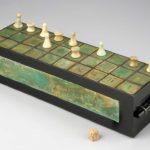
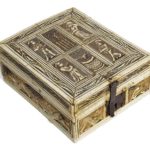
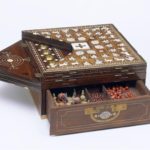
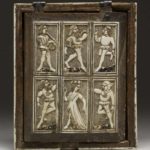

![Playing cards--Besançon tarot BESANÇON: J. JERGER, [1810]](https://allcollectiblegames.com/wp-content/uploads/2021/04/mystical-cards-tarot-french-150x150.jpg)